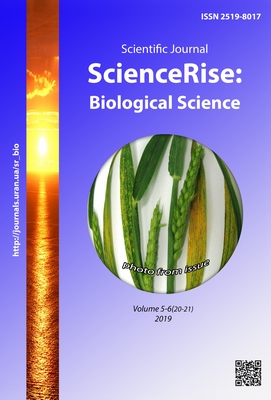Impact of technologically processed rapeseeds on the content of glucosinolates
DOI:
https://doi.org/10.15587/2519-8025.2019.193897Keywords:
rape plant, seeds, press cake, protein meals, processing technology, glucosinolates, effectiveness of using, feedingAbstract
The purpose of the study is to determine the content of glucosinolates in rapeseed and its processing products, depending on the technological methods of its processing at different processing plants.
Materials and methods. The studies were conducted using marketable rapeseed seeds, as well as by-products of its processing into oil - meal and cake. Samples of the initial and final products of processing were selected at those enterprises of Ukraine, which in the last few years have been engaged in processing rapeseed.
The biochemical analysis of samples of seeds, meal and cake was performed by known methods.
Calculated and analytical research methods were used to analyze the results obtained.
Results. The studies have shown that reducing the content of glucosinolates also occurs in the process of industrial processing of commercial rapeseed oil. In the case of oil extraction enterprises, this figure is reduced by 50%, and in enterprises where there are no stages of extraction and toasting - by 25%.
The analysis showed that the content of glucosinolates in domestic products of processing rapeseed (cake, meal) at this stage is an average of 25 μmol/g. However, this level is still higher than what is thought to be used in feeding monogastric animals without restriction, since then the content of glucosinolates in these products should not exceed 20 μmol/g.
Conclusions. The content of the main anti-nutrients in rapeseed meal/cake of domestic production in the current year was 25,1-25,8 µmol/g d.m., which is still higher than the level that allows to use these products of processing rapeseed in feeding monogastric animals without limits
References
- Poberezhna, A. A. (2003). Svitove vyrobnytstvo i vykorystannia shrotiv dlia pidvyshchennia proteinovoi pozhyvnosti kombikormiv. Kormy i kormo vyrobnytstvo, 51, 368–370.
- Schumacher, K. (1992). Worldwide sources of oilseed meals for feed manufacturing. Proceedings of the World Conference on Oilseed Technology and Utilization. Champaign, 352–358.
- Clandinin, D. R., Robblee, A. R. (1981). Rapeseed meal in animal nutrition: II. Nonruminant animals. Journal of the American Oil Chemists’ Society, 58 (6), 682–686. doi: http://doi.org/10.1007/bf02899448
- Thomke, S. (1981). Review of rapeseed meal in animal nutrition: Ruminant animals. Journal of the American Oil Chemists’ Society, 58 (8), 805–810. doi: http://doi.org/10.1007/bf02665585
- Hill, R. (1979). A Review of the “Toxic” Effects of Rapeseed Meals with Observations on Meal from Improved Varieties. British Veterinary Journal, 135 (1), 3–16. doi: http://doi.org/10.1016/s0007-1935(17)32982-2
- Tokey, H. L., Van Ethen, C. H., Daxenbichler, M. E. et. al. (1980). Toxic constituents of Plant Foodstuffs. New York: Academic Press, 504.
- Rutkowski, A., Dabrowski, K. (1983). Zywienie sruta rzepakowa a jakosc mleka, jaj i miesa. Postepy nauk rolniczych, 3, 9–20.
- Demianchuk, H. T., Mykytyn, M. S., Volchovska-Kozak, O. Ye. (2003). Ripak: vid sortu – do yakisnoho nasinnia, olii i kormiv. Oliino-zhyrovyi kompleks, 2, 14–16.
- Rayner, C. J., Fox, M. (1976). Amino acid digestibility studies of autoclaved rapeseed meals using anin vitro enzymatic procedure. Journal of the Science of Food and Agriculture, 27 (7), 643–648. doi: http://doi.org/10.1002/jsfa.2740270709
- Mykytyn, M. S. (2008). Biotekhnolohichna obrobka produktiv vysokoproteinovykh oliinykh kultur. Visnyk ahrarnoi nauky, 8, 43–45.
- Demianchuk, H. T., Mykytyn, M. S. (1994). Zminy vmistu hliukozynolativ ta aktyvnosti mirozynazy v tekhnolohichnomu protsesi pererobky nasinnia ripaku. Visnyk ahrarnoi nauky, 4, 106–109.
- Schumann, W. (2003). Glucosinolate content of rapeseed and rapeseed products in Germany. Proceedings of 11th International Rapeseed Congress. Copenhagen, 4, 1265–1267.
- Rakowska, M., Twarkowska, J., Byczynska, B., Neumann, M., Krzymanski, J. (1979). Effect of glucosinolate content in the seeds of cultivars on the growth, protein efficiency ratio and reproduction of rats. Biuletiu IHAR (Supl.I), 135, 334–349.
Downloads
Published
How to Cite
Issue
Section
License
Copyright (c) 2020 Mykola Mykytyn, Uliana Melnyk, Оleksandra Volchovska-Kozak

This work is licensed under a Creative Commons Attribution 4.0 International License.
Our journal abides by the Creative Commons CC BY copyright rights and permissions for open access journals.
Authors, who are published in this journal, agree to the following conditions:
1. The authors reserve the right to authorship of the work and pass the first publication right of this work to the journal under the terms of a Creative Commons CC BY, which allows others to freely distribute the published research with the obligatory reference to the authors of the original work and the first publication of the work in this journal.
2. The authors have the right to conclude separate supplement agreements that relate to non-exclusive work distribution in the form in which it has been published by the journal (for example, to upload the work to the online storage of the journal or publish it as part of a monograph), provided that the reference to the first publication of the work in this journal is included.









